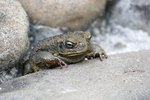
Animals that morph from one creature to another before your eyes are especially fascinating. The frog is one; a tadpole after escaping the egg, he slowly transforms over a season. Water is one of a few basic necessities for development. A tadpole's exact requirements for life vary depending on species.
Water
The one thing tadpoles need above all else is water. Some species have unique adaptations that facilitate their getting to it. For example, the waxy monkey frog lays eggs in leaf nests a few feet above the water's surface so that when the eggs hatch the tadpoles wriggle free and drop into the water below. Some arboreal frog species lay their eggs in water collected in tree trunks, where the tadpoles develop there. Desert frogs may lie underground for months, waiting for rains to create temporary water bodies in which the tadpoles can develop. When tadpoles hatch, they're designed for aquatic life with gills and tails; they develop lungs and legs as they mature.
Food
Tadpoles are basically teenage frogs, which means they need to eat a lot. When they hatch, they need food that's very small, sometimes unicellular. As they grow, they eat just about any living thing that fits in their mouths and shares their watery home. Insect larvae, water striders and even small fish can be prey for tadpoles. The success of a tadpole brood largely depends on the availability of food in the water body and on the number of predators present. Temporary water bodies that serve as insect breeding grounds but are not able to support large animals like fish are ideal tadpole habitats, because food is abundant and predators are nonexistent.
Warmth
In general, warmer water causes eggs to hatch sooner and tadpoles to develop into full-grown frogs faster. This is why most frogs mate in spring and summer. When the water is unseasonably warm, tadpoles develop faster. The required minimum temperature for tadpoles to develop successfully varies significantly depending on species. Tadpoles of species that live in cold areas, like the common bullfrog (Rana catesbeiana) live in waters ranging in temperature of 40 degrees F up to 75 degrees F, depending on the time of year. It can take up to two years for bullfrog tadpoles to develop into adults. It's also possible for tadpoles to survive in ponds over the winter in a hibernation state; common bullfrog tadpoles, for instance, can burrow into the silt of lake bottoms to protect themselves from a winter freeze. Tropical frog species, such as the red-eyed tree frog (Agalychnis callidryas), require water between 70 and 85 degrees F to develop properly.
Raising Tadpoles at Home
An aquarium filled with purified room-temperature water and including a filter is the most basic setup for raising tadpoles. This arrangement will work for most aquatic frog species. You should feed tadpoles regularly but not to the point that they don't search for food. Small tadpoles can eat flake foods; larger tadpoles should have larger prey. Keeping the water quality stable is essential, especially within the first two weeks of tadpole life. Perform partial water changes of about 25 percent weekly. Remove waste and excess food a little at a time to avoid shocking the tadpoles' systems. The pH level should hover around 7.0 for most frog species. Gravel in the bottom of the aquarium and live plants will make an aquarium feel more like tadpoles' natural environment, but they aren't essential. Limit the population to about five to eight tadpoles per gallon of water. The tadpoles will need more space as they grow.
References
- Berkeley -- Harland Xenopus tropicalis Site: Raising Tadpoles Through Adulthood
- Frog Safe, Inc.: Raising Tadpoles in Containers and Ponds
- Tadpoles: The Biology of Anuran Larvae: McDiarmid, Roy W.; Altig, Ronald.
- Nova Scotia Museum: Bull Frog
- Toronto Zoo: Waxy Monkey Tree Frog
- Arizona-Sonora Desert Museum: Couch’s Spadefoot (Scaphiopus couchi)
- The Victorian Frog Group: Keeping Tadpoles: A Guide for Pond Dwelling Species
- Animal Diversity Web: Agalychnis callidryas
Resources
Photo Credits
-
Jupiterimages/Photos.com/Getty Images
Writer Bio
Madeline Masters works as a dog walker and professional writer. In the past she has worked as a fitness columnist, fundraising copywriter and news reporter. Masters won two Pennsylvania Newspaper Association Awards in 2009. She graduated from Elizabethtown College with a Bachelor of Arts in English.



